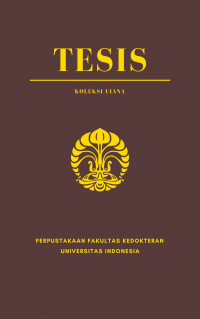Tesis
Profil Penggunaan Obat pada Pasien di Poliklinik Geriatri: Fokus pada Polifarmasi, Pengobatan Berpotensi Tidak Tepat, Ketidakpatuhan Pengobatan dan Interaksi Obat = Profile of Drug Use in Geriatric Polyclinic Patients: Focus on Polypharmacy, Potentially Inappropriate Medicine, Nonadherence to Treatment and Drug Interactions.
Latar Belakang. Polifarmasi, pengobatan berpotensi tidak tepat (PIM), ketidakpatuhan terhadap pengobatan, dan interaksi obat merupakan permasalahan terkait obat pada usia lanjut dan berhubungan dengan sindrom geriatri dan berbagai luaran klinis negatif. Tujuan. Mengetahui karakteristik pasien dan pengobatan yang didapatkannya, mengetahui proporsi polifarmasi, PIM, ketidakpatuhan terhadap pengobatan, dan interaksi obat pada pasien di Poliklinik Geriatri. Metode. Penelitian deskriptif ini dilakukan secara potong-lintang di Rumah Sakit Umum Pusat Nasional Dr. Cipto Mangunkusumo. Sampel diambil secara konsekutif. Melalui wawancara dan telaah rekam medik, data pasien yang dikumpulkan berupa usia, jenis kelamin, tingkat pendidikan, status sosial dan ekonomi, komorbiditas, pengkajian geriatri komprehensif, obat-obatan yang dikonsumsi pasien, PIM berdasarkan kriteria STOPP versi 2 dan Beers 2019, ketidakpatuhan pengobatan berdasarkan MAQ, dan interaksi obat berdasarkan Lexi-Interact Online dari Lexicomp®. Hasil. Dari 101 subjek, didapatkan karakteristik berupa sebagian besar subjek berusia 70 – 79 tahun (57,43%), berpendidikan tinggi (41,58%), menikah (62,38%), tinggal dengan keluarga (87,13%), berpenghasilan di bawah UMR (56,44%), dan berobat dengan Jaminan Kesehatan Nasional (97,03%). Sebagian besar tidak mengalami malnutrisi (78,22%), memiliki fungsi kognitif normal (87,13%), tidak menderita depresi (90,1%), status fungsional mandiri (64,36%), pre-frail (70,3%), dan indeks komorbiditas Charlson sedang (50,5%). Obat antihipertensi merupakan obat yang paling banyak diresepkan (88,12%), terdapat 11,88% subjek mengkonsumsi obat tradisional. Seluruh subjek (100%) memiliki multimorbiditas, komorbid terbanyak adalah hipertensi (85,15%). Polifarmasi terjadi pada 86,14% subjek, PIM berdasarkan kriteria STOPP versi 2 terjadi pada 30,69% subjek, sedangkan berdasarkan kriteria Beers 2019 terjadi pada 36,63% subjek. Ketidakpatuhan terhadap pengobatan terjadi pada 60,4% subjek, dan interaksi antar-obat terjadi pada 82,18% subjek. Kesimpulan. Sebagian besar pasien di Poliklinik Geriatri mengalami polifarmasi, namun hanya sebagian kecil yang mengandung obat berpotensi tidak tepat. Sebagian besar pasien tidak patuh terhadap pengobatan dan mengkonsumsi obatobatan yang mengandung potensi interaksi obat.
Kata kunci. polifarmasi, PIM, ketidakpatuhan pengobatan, interaksi obat, usia lanjut, rawat jalan.
Background. Polypharmacy, potentially inappropriate medicine (PIM), nonadherence to treatment, and drug interactions are drug-related problems that often occur in the elderly and are associated with geriatric syndrome and various clinical outcomes so that it needs attention in administering drugs for elderly patients. . Aim. Knowing character of the patients and the treatment they received, looking at polypharmacy, PIM, non-adherence to treatment, and drug interactions in patients at the Geriatric Polyclinic. Method. It is a cross-sectional study done in March - April 2020 at Dr. Cipto Mangunkusumo. The subject selecting based on consecutive sampling. Subjects are interviewed with questionnaires and review the patient's medical records to obtain data on age, gender, education level, social and economic status, comorbidities, comprehensive geriatric assessments, drugs consumed by patients, PIM based on STOPP version 2 and Beers 2019 criteria, adherence of treatment with MAQ, and drug interactions based on Lexi-Interact Online from Lexicomp®. Result. Of the 101 subjects, most of the subjects were 70-79 years old (57.43%), female (54.46%), highly educated (41.58%), married (62.38%), living with family (87.13%), earning below the UMR (56.44%), and seeking treatment with the National Health Insurance (97.03%). Most of them are not malnourished (78.22%), have normal cognitive function (87.13%), do not suffer from depression (90.1%), independent functional status (64.36%), pre-frail (70.3 %), and have moderate Charlson's comorbidity index (50.5%). Anti-hypertensive drugs were the most prescribed drug (88.12%), 11.88% of patients consumed traditional medicine. All subjects (100%) had multimorbidity, the most common comorbid was hypertension (85.15%). Polypharmacy occurred in 86.14% of subjects, PIM based on the STOPP version 2 criteria occurred in 30.69% of subjects, and based on Beers 2019 criteria occurred in 36.63% of subjects. Nonadherence to treatment did occur in 60.4% of subjects, and drug interactions occurred in 82.18% of subjects. Conclusion. Most elderly patients in the Geriatric Polyclinic experience polypharmacy, but only a small proportion of them contain PIM. Most of the patients do not adhere to treatment, and take drugs that involve drug interactions.
Keywords. polypharmacy, PIM, medication non-compliance, drug interactions, elderly, outpatient.
- Judul Seri
-
-
- Tahun Terbit
-
2021
- Pengarang
-
Vinandia Irvianita Poespitasari - Nama Orang
Noto Dwimartutie - Nama Orang
Siti Setiati - Nama Orang
Arief Mansjoer - Nama Orang - No. Panggil
-
T21027fk
- Penerbit
- Jakarta : Program Studi Ilmu Penyakit Dalam., 2021
- Deskripsi Fisik
-
xxvii, 163 hlm. ; 21 x 30 cm
- Bahasa
-
Indonesia
- ISBN/ISSN
-
-
- Klasifikasi
-
NONE
- Edisi
-
-
- Subjek
- Info Detail Spesifik
-
Tanpa Hardcopy
| T21027fk | T21027fk | Perpustakaan FKUI | Tersedia |


Masuk ke area anggota untuk memberikan review tentang koleksi